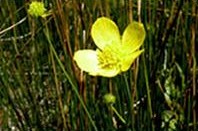Ranunculus aestivalis
| Ranunculus aestivalis | |
|---|---|

| |
| Scientific classification | |
| Kingdom: | Plantae |
| Clade: | Tracheophytes |
| Clade: | Angiosperms |
| Clade: | Eudicots |
| Order: | Ranunculales |
| Family: | Ranunculaceae |
| Genus: | Ranunculus |
| Species: | R. aestivalis
|
| Binomial name | |
| Ranunculus aestivalis (L.D. Benson) Van Buren & Harper
| |
Ranunculus aestivalis is a rare species of buttercup known by the common names fall buttercup[1] and autumn buttercup. It is endemic to the state of Utah in the United States, where it exists only in Garfield County next to the Sevier River.[2] It is restricted to a moist microhabitat in an otherwise dry, open ecosystem, and the amount of available habitat is very limited.[3] This is a federally listed endangered species of the United States. It has been described as "the most graceful and showy members of the genus in the western United States," but also "one of the state's rarest and most restricted plants."[3]
This plant is often treated as a variety of Ranunculus acriformis[4] or Ranunculus acris.[1] A genetic analysis study showed it to be sufficiently separate and it was elevated to species status by one group of authors in 1994.[5]
Description
This plant produces a hairy, erect stem 30 to 60 centimeters tall. The leaves are divided into three dissected parts, or sometimes three leaflets. Each plant produces about 6 to 10 flowers.[3] The flower has five, or occasionally ten yellow petals each around a centimeter long.[4] Blooming occurs in July through October, giving the plant its common name.[3] The specific epithet, aestivalis, comes from Latin and means "pertaining to the summer".[6]
Distribution and habitat
This wildflower grows in wet
Threats to the plant include changes in the local
Taxonomy
This plant was feared extinct in the 1970s and was rediscovered in 1982.
References
- ^ a b USDA, NRCS (n.d.). "Ranunculus aestivalis". The PLANTS Database (plants.usda.gov). Greensboro, North Carolina: National Plant Data Team. Retrieved 18 October 2015.
- ^ a b c Ranunculus aestivalis. Archived 2011-10-26 at the Wayback Machine Center for Plant Conservation.
- ^ a b c d e f Ranunculus aestivalis. The Nature Conservancy.
- ^ a b Ranunculus acriformis var. aestivalis. Flora of North America.
- ^ Van Buren, R., et al. (1994). Evaluating the relationship of autumn buttercup (Ranunculus acriformis var. aestivalis) to some close congeners using random amplified polymorphic DNA. Am J Bot 81(4) 514-19.
- ISBN 978-3-540-00489-9. Retrieved 12 November 2018.
- ^ Ranunculus aestivalis. Utah DNR.
- ^ a b c Whitney, S. A bloomin' project – Can the endangered autumn buttercup be saved? Deseret News September 28, 2007.
- ^ Autumn Buttercup Preserve. The Nature Conservancy.

